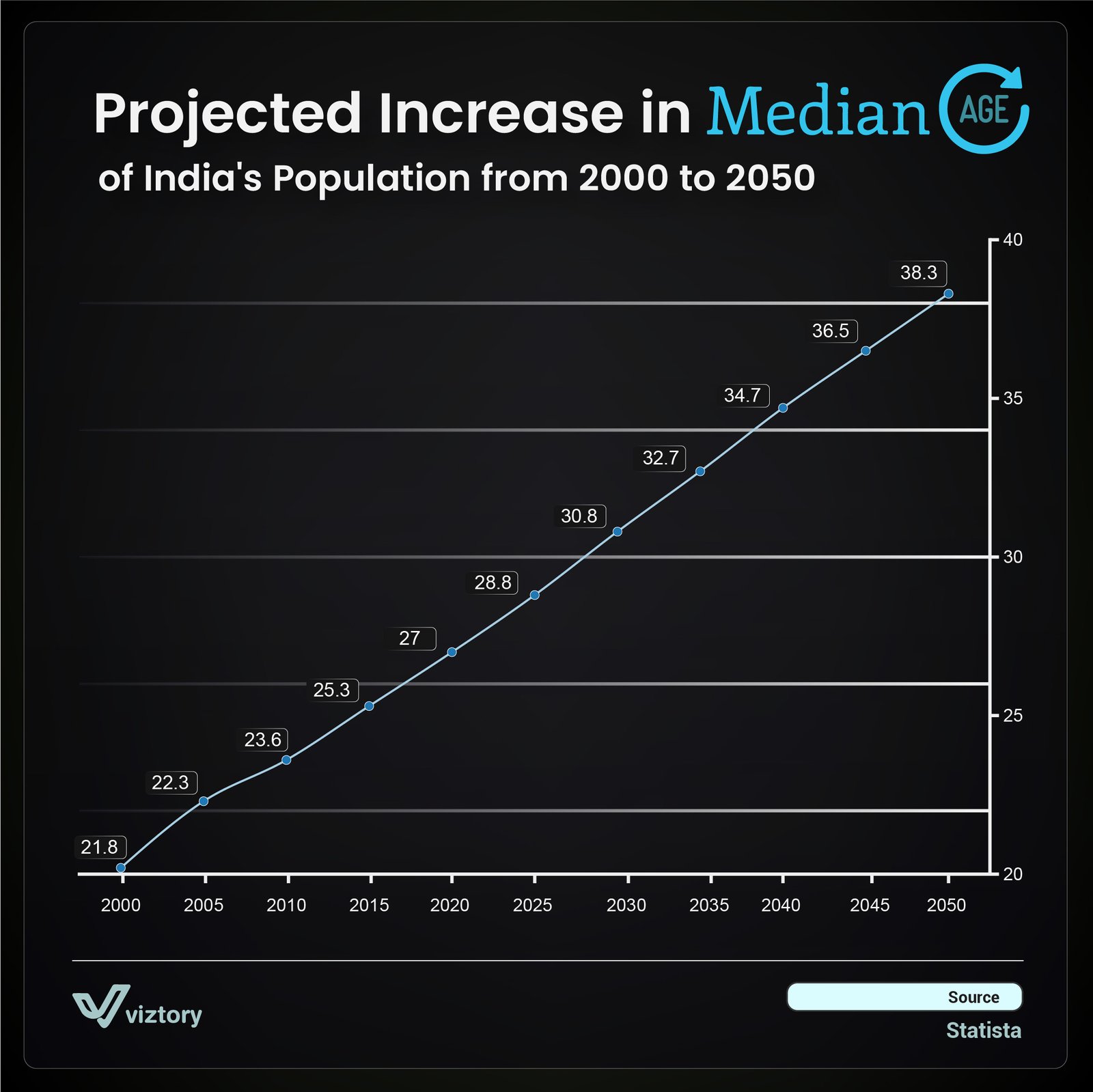Projected Median Age and Healthcare Implications (2000-2050)
-
Oct, Tue, 2024
India’s Aging Population: Projected Median Age and Healthcare Implications (2000-2050)
The median age of India’s population is projected to increase significantly from 21.8 years in 2000 to 38.3 years by 2050, as shown in the visualization. This demographic shift has far-reaching implications for the country’s healthcare system, which will need to adapt to meet the evolving needs of an aging population. As India transitions from a predominantly young nation to one with a more balanced age distribution, healthcare challenges and opportunities will arise.
Aging Population and Rising Healthcare Demands
An increase in median age typically leads to higher healthcare demands, as older populations are more prone to chronic illnesses and age-related conditions. With India’s median age expected to reach 38.3 years by 2050, the healthcare system will need to focus more on managing chronic diseases such as diabetes, hypertension, and cardiovascular diseases. These conditions require long-term care and consistent medical attention, underscoring the need for a robust healthcare infrastructure capable of supporting an aging population.
Shifting Focus from Infectious to Chronic Diseases
As the median age rises, India’s healthcare priorities are likely to shift from infectious disease management to chronic and non-communicable diseases. This shift mirrors the experience of other countries that have undergone demographic transitions. With an older population, India will face increased incidences of cancer, dementia, and other age-related illnesses, necessitating investment in specialized care facilities, training for healthcare professionals, and public health initiatives tailored to chronic disease prevention and management.
Healthcare Workforce and Geriatric Care
The projected increase in India’s median age will require an expanded and specialized healthcare workforce. Geriatric care will become more prominent, with a need for healthcare professionals trained to address the unique medical, psychological, and social needs of older adults. Developing geriatric care programs and increasing the number of healthcare providers skilled in elder care will be essential to meet the demands of an aging population. Furthermore, expanding access to home-based care and telemedicine could alleviate some of the pressures on hospitals and care facilities.
Economic Implications and Healthcare Funding
An aging population can strain healthcare funding, as more resources are allocated toward managing chronic illnesses and providing long-term care. As India’s workforce ages, the potential for decreased productivity and increased healthcare costs could impact the country’s economy. Ensuring sustainable healthcare funding will be crucial to supporting India’s aging population. This may involve public-private partnerships, increased government spending on healthcare, and policies aimed at improving the efficiency and accessibility of healthcare services.
Preventive Healthcare and Healthy Aging
Promoting preventive healthcare will be vital to mitigating the impact of an aging population on India’s healthcare system. Encouraging healthy aging through lifestyle changes, regular screenings, and early interventions can help reduce the prevalence of chronic diseases and improve quality of life for older adults. Public health campaigns focused on nutrition, physical activity, and mental health can play a significant role in fostering a healthier aging population, reducing the burden on healthcare services.
Conclusion
India’s projected increase in median age reflects a broader demographic transition that will reshape the country’s healthcare landscape. As the population ages, adapting healthcare services to meet the needs of older adults will be essential. From managing chronic diseases to expanding geriatric care, the challenges posed by an aging population also present opportunities for innovation in healthcare delivery. By focusing on preventive care and investing in healthcare infrastructure, India can support its aging population while ensuring that its healthcare system remains resilient and responsive to future demands.

